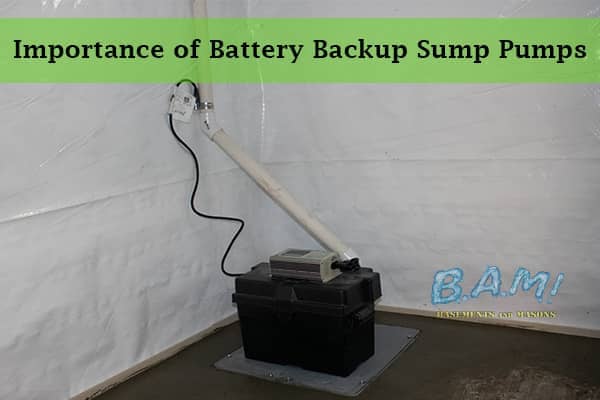Best Basement Waterproofing Fundamentals Explained
Table of ContentsThe 30-Second Trick For Best Basement WaterproofingExcitement About Best Basement WaterproofingMore About Best Basement WaterproofingThe smart Trick of Best Basement Waterproofing That Nobody is DiscussingNot known Factual Statements About Best Basement Waterproofing
AdvantaClean's qualified experts and service technicians will certainly situate the water source. If wall or slab fractures are existing, we will inject polyurethane and epoxies right into the fractures and secure the compromise, stopping additional dampness from entering.If there's condensation on the exterior of the aluminum foil, you have high moisture in your cellar. If the foil has condensation on the within surface area (following to the wall), the soil around your house may be naturally damp from a high water table or inadequate soil drain.
You can waterproof simply your indoor wall surfaces, which might solve the problem. Or you can waterproof your outside walls, which is a much better wager however even more expensive. Right here's the inside story on the different kinds: These thick coverings are cement-like. Once they dry out, they stick completely to concrete and stonework walls (Best Basement Waterproofing).
7 Easy Facts About Best Basement Waterproofing Shown
Concrete water resistant finishings can not be used to formerly repainted surface areas; examine the tag. Understood as densifiers, they are appropriate only for walls that have not been painted or secured.
You comb, roll, or spray it on much even more heavily one gallon covers just 75 square feet, not the 300 square feet common with standard paint. Water resistant paint is fine for do it yourself application. You can use it over painted surfaces, and paint over it once it's cured (one gallon expenses $37).
It can set you back $10,000 to $15,000, relying on the job needed. Outside waterproofing entails excavating all around the residence to the full deepness of the structure wall surfaces, after that installing a water-proof layer or membrane covered by drainage panels. The panels provide a simple path for water to flow down to an exterior French drain at the end of your structure.
A cellar without waterproofing is kind of like that. Your basement does not want to go with a downpour without proper defense just as much as you don't want to.
The Facts About Best Basement Waterproofing Revealed
If you've done your research, you would certainly recognize there are 2 types of waterproofing: inside and outside. It can obtain puzzling what they both mean, which one's a much better investment, and what will really maintain the water out. Do not worry, we put with each other this blog site to conveniently specify both methods for you and review the pros and cons of each.
Exterior waterproofing is a waterproofing click for more info technique that involves securing your home from the exterior. It's sort of like a moat around a castle. It More Bonuses entails digging a trench around your entire home to the structure (concerning 8 to 10 feet down). The structure walls are after that cleansed, sealed, and covered with a water-proof membrane or sealer.

The smart Trick of Best Basement Waterproofing That Nobody is Talking About
It's a more involved process that requires excavating up your backyard, which is costly and time-consuming. Exterior waterproofing entails removing whatever bordering your home, including porches, driveways, walkways, landscaping, air conditioning units, decks, and so forth. If any of the work was done incorrectly and water is still entering your basement, there isn't much you can do to remedy or repair it.
Inside cellar waterproofing involves waterproofing from the inside. Any kind of water that leaks right into your basement is redirected before it touches your floor. It's sort of like putting on a raincoat under your clothing. It involves two points: a water drain track and a sump pump. It works by sealing the within your basement walls and floorings so water that attempts to go into is funnelled out with a sump pump.
It's a reliable technique to water resistant your cellar - Best Basement Waterproofing. The downside of interior cellar waterproofing mainly has to do with the installation process. This method needs kept things, furnishings, and built-in shelving or closets to be moved from touching the basement walls. And during installation, your cellar can not be used. The most significant difference between the 2 techniques is this: Exterior waterproofing is a preventative option and indoor waterproofing is a corrective solution.
What Does Best Basement Waterproofing Mean?
To conclude, exterior and interior cellar waterproofing are both efficient techniques of protecting your home from water damage. Outside waterproofing creates a barrier that avoids water from entering your home, while interior waterproofing redirects water that does enter your home. And it is essential to keep in mind that exterior waterproofing is an expensive and disruptive installation process when contrasted to indoor waterproofing.
Whichever technique you pick, make sure you pick a trusted and trustworthy specialist for the task. Both methods require experienced employees to deal with the work. If you have any kind of questions regarding cellar waterproofing, please get to out to us. And if you remain in visit homepage our solution area and have water in your cellar, contact us for a cost-free, no-obligation home inspection.
You can fill up out our type right here, start a conversation in the bottom right-hand edge, or call us at 1-800-827-0702.